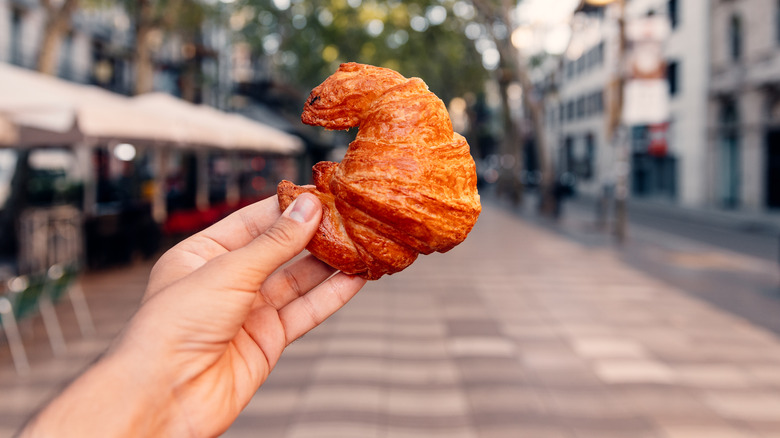The Origin Of Croissants Isn't What You Might Expect
Ah, the croissant. It's as French as a frog, smoking a cigarette while riding a bicycle made of cheese down the Champs-Élysées, right? Wrong. As it turns out, everyone's favorite French pastry isn't French at all ... it's Austrian. Sacrebleu!
In reality, though, it's not quite as black and white as all that. Most food historians agree that the croissant traces its origins back to the 13th century, when Austrian bakers created the kipferl (meaning "crescent" in German). The story goes that it was inspired by the defeat of the Ottoman Empire (which had a crescent moon on its flag) in battle — but there's no real evidence of this.
What we do know for sure is that it eventually made its way to France in the 19th century. A common, but unfortunately unsubstantiated, legend claims that Marie Antoinette (another French icon born in Austria) was responsible for first bringing it to the court at Versailles, longing for a taste of home. "Let them eat kipferl" just doesn't have quite the same ring to it, does it?
How the kipferl became the croissant
The first record we have of the kipferl's introduction to France is the opening of an Austrian bakery in 1839 by an artillery officer named August Zang. This bakery, called Boulangerie Viennoise, became a sensation, and over the next few years, Parisians became enamored with Viennese baking. Before long, the French had christened the kipferl with a new name, translating it into their own language: croissant.
These early croissants, however, weren't exactly the familiar pastries we know today. They were actually brioche buns, more akin to a brioche au sucre than anything else. It wasn't until 1915 that a baker named Sylvain Claudius Goy wrote the first version of the definitive butter croissant recipe, using laminated pastry instead of the original brioche. Lamination refers to the process used to make croissant dough (and that of other pastries, such as the Catalunyan xuixo, or another French classic, the onion tart), and involves layering butter and dough to create the distinctive flaky texture for which Viennoiserie is famous.
Though the croissant has since taken on a life of its own, far eclipsing its Austrian progenitor, the legacy of Viennese pastry lives on in pâtisseries across Paris and beyond — and if you look hard enough, the original kipferl is still out there to be found.


